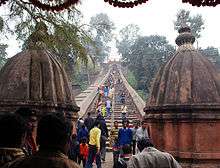Hajo
Hajo (Assamese: হাজো) is an ancient pilgrimage centre for three religions: Hinduism, Buddhism, and Islam. Hajo word is derived from Bodo word 'Hajw' which means Hill[1]. It lies on the banks of the Brahmaputra River, 24 km from the city of Guwahati in the Kamrup district of Assam, India. The area is dotted with a number of ancient temples as well as other sacred artifacts. The Hayagriva Madhava Mandir is the most famous temple of Hajo.[2] Lesser known temples of Hajo like that of Ganesha was constructed during the reign of Ahom King Pramatta Singha in 1744 AD. The Kedareswara Temple, a Shiva temple, has an inscription on the temple showing that it is of Rajeswar Singha period. Hajo is also famous for Barmaqam Powa Makkah which is an ancient mosque and contains the shrine of a Muslim preacher.

Tourism Attractions
- Hayagriva Madhava Temple is situated on the Monikut hill. The present temple structure was constructed by the King Raghudeva Narayan in 1583. According to some historians, the King of Pala dynasty constructed it in the 6th century. It is a stone temple and it enshrines an image of Hayagriva Madhava. Some Buddhists believe that the Hayagriva Madhava temple, best known in the group of Hindu temples, is where the Buddha attained Nirvana. At this imposing temple, the presiding deity is worshipped as the Man Lion incarnation of Vishnu by the Hindus.[3] It is a stone temple and it enshrines an image of Hayagriva Madhav. The rows of elephants are seen on the body of the temple and they are fine specimens of Assamese art. There is a big pond known as Madhab Pukhuri near the temple. Doul, Bihu and Janmastami festivals are celebrated every year in the temple. Moreover, this temple preaches both Hinduism and Buddhism, which attract Buddhist Monks from far-flung places. Sayani, the first wife of Kalia Bhomora Borphukan donated a family of paiks and also a plot of land for their maintenance to the Hayagriva Madhava temple during the reign of Ahom king Kamaleswar Singha.

- Barmaqam Powa Makkah: Hajo is also a Muslim tourist attraction. Powa Makkah, meaning a quarter of Makkah, also known as Barmaqam, is a place of pilgrimage for the Muslims, situated atop the Garurachala Hills. An Iraqi prince and preacher, Ghiyath ad-Din Awliya, is said to have built a khanqah here in the 12th century. It is held by the Muslims that the preacher had brought a lump of earth from Makkah and enshrined the same at a spot where the khanqah was built at a later period. It is believed that by offering prayer, a faithful gains one-fourth (Powa) spiritual enlightenment of what could be gained at Makkah and so this place is known as Powa-Makkah. A Persian epigraph at the site indicates that the mosque of Powa Makkah was built in 1657 by Lutfullah Shirazi during the reign of Emperor Shah Jahan. A pilgrimage to this shrine is believed to be equivalent to a quarter of the piety attained by a Haj pilgrimage to Makkah. The Ahom King, Rudra Singha, continued to pay great attention to this Muslim shrine at Powa Makkah even after the expulsion of the Mughals from Assam in 1682. During the months of March and April, thousands of Hindu and Muslim pilgrims assemble here to celebrate Urs.
- Madan Kamdev Temple:This temple is located 42 km east from Hajo. It is situated on top of the Dewangiri Hillock. It is one of the ancient Hindu temples of Kamrup District.
- Kedareswara Temple:This is a Shiva temple with inscriptions showing it to be built during the Rajeswar Singha period.
Politics
Hajo is part of Gauhati (Lok Sabha constituency).[4]
See also
References
- Nath, D. "History of the Koch Kingdom, C. 1515-1615".
- Zaman, Owahedur (2019). "Manikut_Sujabad_Hajo_etc"
- "Temples of North Eastern India". Retrieved 10 September 2006.
- "List of Parliamentary & Assembly Constituencies" (PDF). Assam. Election Commission of India. Archived from the original (PDF) on 4 May 2006. Retrieved 5 October 2008.
External links
| Wikimedia Commons has media related to Hajo, Assam. |